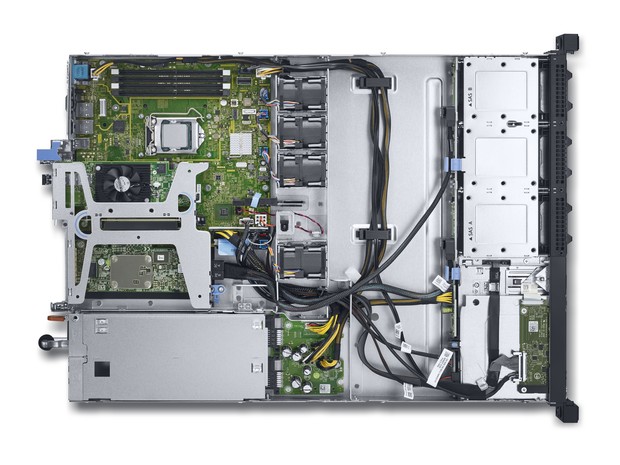REVIEW FOR THE DELL POWEREDGE R330 STANDS TALL FOR SMALL SHOPS.
Source: Itnews.com
Single-socket, rack-mount R330 offers plentiful horsepower and flexibility to small offices and remote sites.
Choosing a small-business or remote-site server has always involved trade-offs. You can’t spend too much, but you don’t want to aim too short and deploy undersized hardware that you’ll wind up replacing later.
Further, you might not need all the bells and whistles of enterprise-class hardware, but you will need a few key items, such as extensive remote management features, redundant power supplies, hardware RAID, and, of course, reliability.
The Dell PowerEdge R330 has all of these prerequisites, balanced against the need to not bust the budget. This 1U, single-CPU server offers available redundant power supplies, Dell’s solid iDRAC remote management features, adequate RAM with a max of 64GB, and adequate CPU resources for small deployments with support for the Intel Pentium, Intel Core i3, and Intel Xeon E3-1200 v5 product families.
You can certainly add enough extras to substantially up the price of the R330, but starting at a little more than $1,000 for the baseline configuration, it offers excellent bang for the buck.
Hardware smorgasbord.
The baseline CPU is a 2.8GHz Intel Celeron G3900 with 2MB cache and two cores, through a 3.7GHz Intel Xeon E3-1280 v5 with 8MB cache and four cores. In all, there are 11 processor options to choose from. You can squeeze 64GB of RAM into the R330 with 16GB UDIMMs in each of the four sockets, or as little as 4GB with a single UDIMM.

There are many options for storage on the R330 as well. You can select a chassis with four 3.5-inch drives, or eight 2.5-inch drives, or four 3.5-inch drives and an embedded 1.8-inch SATA SSD, and a choice of cabled or hot-swap disks. If you select 2.5-inch drives, they will be hot-swap.

As for the disks themselves, you have another wide range of choices. Depending on size and controller configuration, the R330 supports SATA, 10K and 15K SAS, NL-SAS, and SSD drives, in capacities up to 2TB for SATA and NL-SAS, 1.8TB for SAS, and 1.6TB for SSD, though that 1.6TB SSD will run you more than $2,500 alone.
Also, you can choose a standard SATA controller, a PERC H330, or a H730-integrated RAID controller for those disks. There’s also support for internal single- and dual-card slots, so you can forgo the disk altogether if you simply need to boot a hypervisor - a primary use case for the R330.
Ins and outs.
As far as network I/O goes, the R330 includes two built-in gigabit Ethernet interfaces, and two PCIe 3.0 slots, though one is full-height and one is low-profile. The upshot is you can add up to eight more 1GB Ethernet interfaces, or up to four 10GB 10GBase-T or SFP+ interfaces, or you can mix single- and dual-port Ethernet interfaces with single- and dual-port Fibre Channel HBAs and converged network adapters.
You can even leverage the PCIe slots to drive external disk with an external PERC RAID controller or SAS HBA.

Remote control.
Rounding out the picture is the iDRAC remote management controller. This can be included with a dedicated NIC, or it can borrow one of the system gigabit NICs for connectivity. In many cases, having the iDRAC use one of the system NICs isn’t a bad choice, with the understanding you may need to configure VLAN trunking to that port in order to separate the management network from the production network. On the other hand, the iDRAC can be configured to use both built-in ports for failover, so your choice will depend on your infrastructure..
The Dell PowerEdge R330 is a server for the smaller side, such as branch offices and small businesses, but its wide range of options can help it find a home in an infrastructure of nearly any size. Supported host operating systems include Windows Server 2012 and Windows Server 2012 R2, Red Hat Enterprise Linux, Suse Linux Enterprise Server 12, and VMware vSphere ESXi.
If you’re looking for a cost-effective way to deploy a small virtualization cluster at a remote site or to build a small development infrastructure, the options accompanying the R330 make it likely to fit your needs. The extensive and robust remote management tools found in the iDRAC are specifically desirable in remote deployments or wherever the server and server manager are unlikely to occupy the same building.
This story, "Review: Dell PowerEdge R330 stands tall for small shops" was originally published by InfoWorld. Just click to the link below for more info.
Leave a Comment
Let Millions of People know about your Product(s) / Service(s)
Target a Specific Audience on different News Categories
Our Partners
"Making the simple complicated is commonplace; making the complicated simple, awesomely simple, that's creativity"
- Charles Mingus

















































